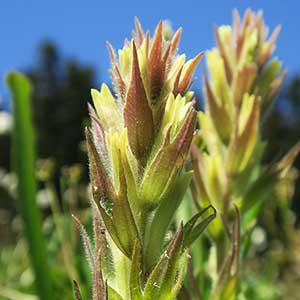Castilleja cryptantha
Castilleja tenuis
Mt. Rainier or obscure paintbrush, obscure Indian paintbrush, obscure paintbrush
annual white paintbrush, hairy Indian paintbrush, hairy owl's-clover, hairy owl-clover, hairy paintbrush, slender paintbrush, thin paintbrush
few to several, erect or ascending, unbranched, hairs spreading, long, soft, eglandular, mixed with short stipitate-glandular ones.
solitary, erect, unbranched or with few upright branches, hairs spreading, long, soft, mixed with shorter, eglandular and glandular ones.
green, often with brown or purple veins, narrowly to broadly lanceolate, 1.5–4 cm, not fleshy, margins plane, ± involute, 0–3-lobed, apex acute to acuminate;
lobes spreading-ascending, narrowly lanceolate, apex acute to ± obtuse.
green to brown, proximal linear, distal lanceolate, 0.7–4(–8) cm, not fleshy, margins plane, flat, 0–3(–5)-lobed, apex acuminate;
lobes ascending-spreading, very long linear, apex acute.
(2.5–)3–6 × 1–2 cm; green to dull brown or dull reddish purple throughout, or proximally green to dull brown or dull reddish purple, distally yellow on apices, broadly lanceolate to ovate, (0–)3-lobed;
lobes ascending, narrowly lanceolate, long or short, arising near mid length, apex acute or acuminate.
2–25 × 1–3 cm;
bracts green, sometimes proximally green, distally dull brownish to deep purplish brown, lanceolate to narrowly ovate or ovate, (3–)5–7(–9)-lobed;
lobes ascending to erect, linear or narrowly lanceolate, long, proximal lobes arising below mid length, apex acute to acuminate.
straight, 14–16 mm;
tube 11–14 mm;
whole corolla included within calyx;
beak adaxially pale yellow, 1–2 mm;
abaxial lip deep green, slightly inflated, 4–5 mm, 67% as long as beak;
teeth ascending, pale, 1.5–2 mm.
straight to ± curved distally, 12–20 mm;
tube 9–14 mm;
abaxial lip and beak exserted;
beak adaxially white or pale yellowish, 3.5–5 mm, inconspicuously puberulent;
abaxial lip white or yellow, 3 small red-brown dots near base, inflated, pouches 3, 2–4 mm wide, 2 mm deep, 2–4 mm, 50–70% as long as beak;
teeth erect, white or yellow, 0.5–1 mm.
proximally green or pale with green veins, lobes yellow, sometimes becoming deep red with age, 12–15 mm;
abaxial and adaxial clefts 3–7 mm, 25–50% of calyx length, deeper than laterals, lateral 1–3(–4) mm, 8–20% of calyx length;
lobes triangular, adaxial segments longer than abaxials, apex acute or obtuse.
green to brownish, margins sometimes deep purple or brown, 6–12 mm;
abaxial and adaxial clefts 2–5 mm, 33–50% of calyx length, deeper than laterals, lateral 2–3.5 mm, 30–40% of calyx length;
lobes linear to narrowly lanceolate, apex acute to acuminate.
included within beak.
= 24.
= 24, 48.
Castilleja cryptantha
Castilleja tenuis
Castilleja cryptantha is endemic to the vicinity of Mt. Rainier in the Cascade Range, with most populations found within Mt. Rainier National Park. Unlike most species of Castilleja, it is apparently self-pollinating (W. J. Duffield 1972); the small flowers are entirely enclosed within the yellowish calyces, which tend to grow deep reddish as they age. The purplish brown bracts are also unusual in the genus.
(Discussion copyrighted by Flora of North America; reprinted with permission.)
Castilleja tenuis is restricted to the east side of the Cascade Range in British Columbia and Washington and also occurs west of the Cascade-Sierra axis in the more arid terrain of California and Oregon. Plants in the Umpqua and Willamette valleys of western Oregon are often taller, more robust, and with slightly larger flowers than is typical in other regions. There are two color forms, with white or yellow corollas, but most individual populations are consistently unicolored. More investigation is needed to determine if corolla color is influenced by genetic and/or environmental factors. There is some evidence (T. I. Chuang and L. R. Heckard 1982) that the colors are correlated to chromosome number, with the white-flowered plants being diploid, while the yellow-flowered plants are tetraploid; however, there are exceptions. D. D. Keck (1927) cited some evidence for seasonal change, with yellow flowers occurring early, replaced with white flowers later in the season. However, no unequivocal evidence exists to support this hypothesis, and the apparently complete absence of yellow-flowered plants in Oregon makes this an unlikely explanation. Cropping by grazing animals results in occasional plants that branch. Plants with slightly curved corolla beaks were described as Orthocarpus falcatus but have no geographic integrity or taxonomic significance. Castilleja tenuis was collected as a waif in Skagway, Alaska, a century ago.
(Discussion copyrighted by Flora of North America; reprinted with permission.)
- Local floras:
BC,
CA,
OR,
WA
- Local Web sites:
CalFlora,
CalPhotos,
Flora NW,
PNW Herbaria,
Turner Photog.
WildflowerSearch
iNaturalist (observations)
USDA Plants Database
- LBJ Wildflower Center
- SEINet
- Plants of the World Online
- Encyclopedia of Life
- Wikipedia
- Google Image Search


